|
November 19, 2001
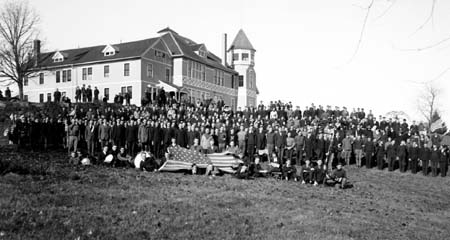 |
[ABOVE] To the shrieking of whistles and tolling
of bells, Connecticut Agricultural College (CAC) students and
faculty paraded around the campus on the morning of November 11,
1918 to celebrate the signing of the armistice that ended World War
I. They then posed near Old Main for this photograph taken by
faculty member Jerauld Manter, the unofficial college photographer.
That night, they gathered again to light a huge bonfire.
To locate this view, please go to an image of
the campus map of 1920.
[Photos From University
Archives]
|
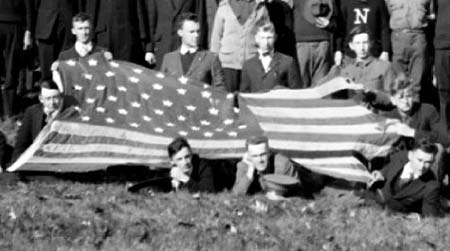 |
[ABOVE] This close-up from the group photograph
shows the America flag held at center by several students. It is
tatered and torn. Whether it was the campus flag or sent from the
war in Europe is unknown. The student body consisted of men in the
Student Army Training Corps (SATC), who were enrolled in special
military training courses, and women who were taking the regular
college curriculum courses.
|
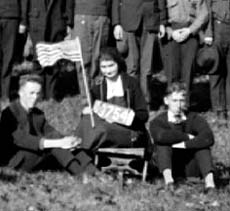 |
[ABOVE] To the right of the large
American flag in the main photograph is a woman sitting on a stool.
She is waving an American flag and around her neck is a sign with a
number -- the significance of the number is unknown.
|
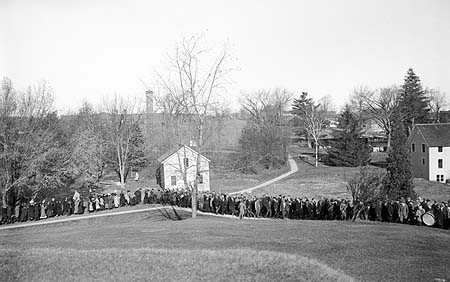 |
[ABOVE] Before posing beside Old
Main -- the main campus facility, built in 1890 -- everyone paraded
around the campus. This view looks north, toward the then unpaved
North Eagleville Road, probably taken from the roof of
the Old Main building. To the right is the back of Whitney Hall,
which faced on to what is now Route 195.
"Permission for suspension of classes being granted, joyous
demonstrations became unrestrained. Exuberance of feeling and
happiness gave vent to snake dances and long chain marches,"
said The Connecticut Campus in its bi-monthly issue of
November 29 (Volume V, No. 1). Months later, a letter to the editor
from a soldier in Europe referred to the article and noted that the
response to the armistice was very different on the front lines:
"..you write of such celebration, but we did not dare as the
ground we trod upon at that time was still fresh from footprints of
friends who had missed the news." The letter writer, Sergeant
Nat Cohen, possibly a CAC graduate, said it was three days after
November 11 before he and his men "started to feel
happy."
|
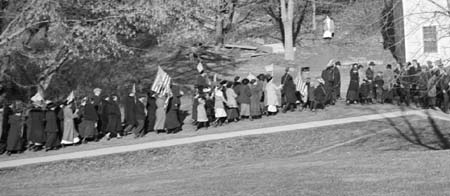 |
[ABOVE] A close-up from the
parade photograph shows a lone observer as the flag-waving marchers
pass by to the right of the Duck Pond beyond the trees. Today is it
known as Swan Lake.
|
 |
[ABOVE] This close-up from the
right side of the photograph shows a drummer beating a bass drum as
the marchers turn south to head toward Old Main.
|
 |
[ABOVE] "Throughout the day,
the campus continually gave evidences of celebration,"
reported the Campus. A meeting at 11 a.m. in Hawley Armory
included cheering led by Companies A and B of the Student Army
Training Corps and community singing of songs such as "Pack Up
Your Troubles" - "sung with more than the usual vim and
enthusiasm" noted the Campus. Community signing
continued through the day, as did preparations for an evening
gathering for bonfire. "The huge bonfire, the largest ever
held at Storrs, was built under the direction of A.E. Moss (Albert
Moss, professor of forestry) and A.G. Skinner on the top of
Vineyard Hill."
|
 |
[ABOVE] "Promptly at seven
o'clock the stack was fired by Mrs. C. L. Beach, and as it
burst into flames a great cheer arose from the audience,"
reported the Campus. At left in the photograph above is
CAC President Charles L. Beach, who waves an American flag as his
wife, right, prepares to lit the fire (detail below). Among the
"stunts" presented by students was a "tableau"
performed by co-eds, depicting the flags of five allied nations.
They sang the national anthem of each country, and their part of
the ceremony closed with "The Star Spangled Banner."
Faculty, with one portraying the devil, performed a mock trial of
Germany's Kaiser Wilhelm which ended with the effigy of
"Kaiser Bill" being thrown onto the fire, having been
rejected as an entrant to Hell. "The program was concluded
with Joan D'Arc dressed in flowing white robes and seated on a
white horse."
|
 |
[ABOVE] Louise Crombie Beach had
the honor of lighting the fire that set off the final event of the
day of celebration. The man behind her is not identified, but it is
possibly Edwin O. Smith, a faculty member and later a state
legislator.
|
Mark J. Roy
|